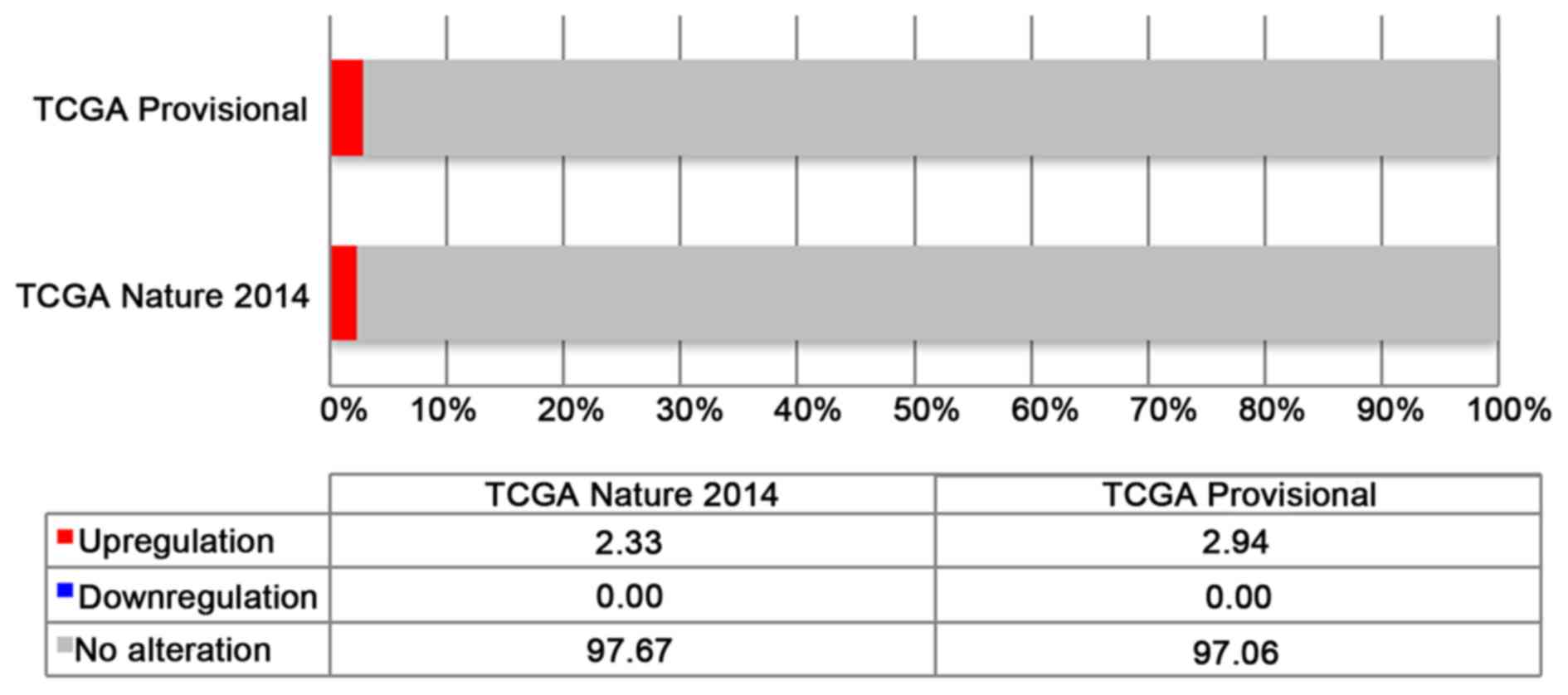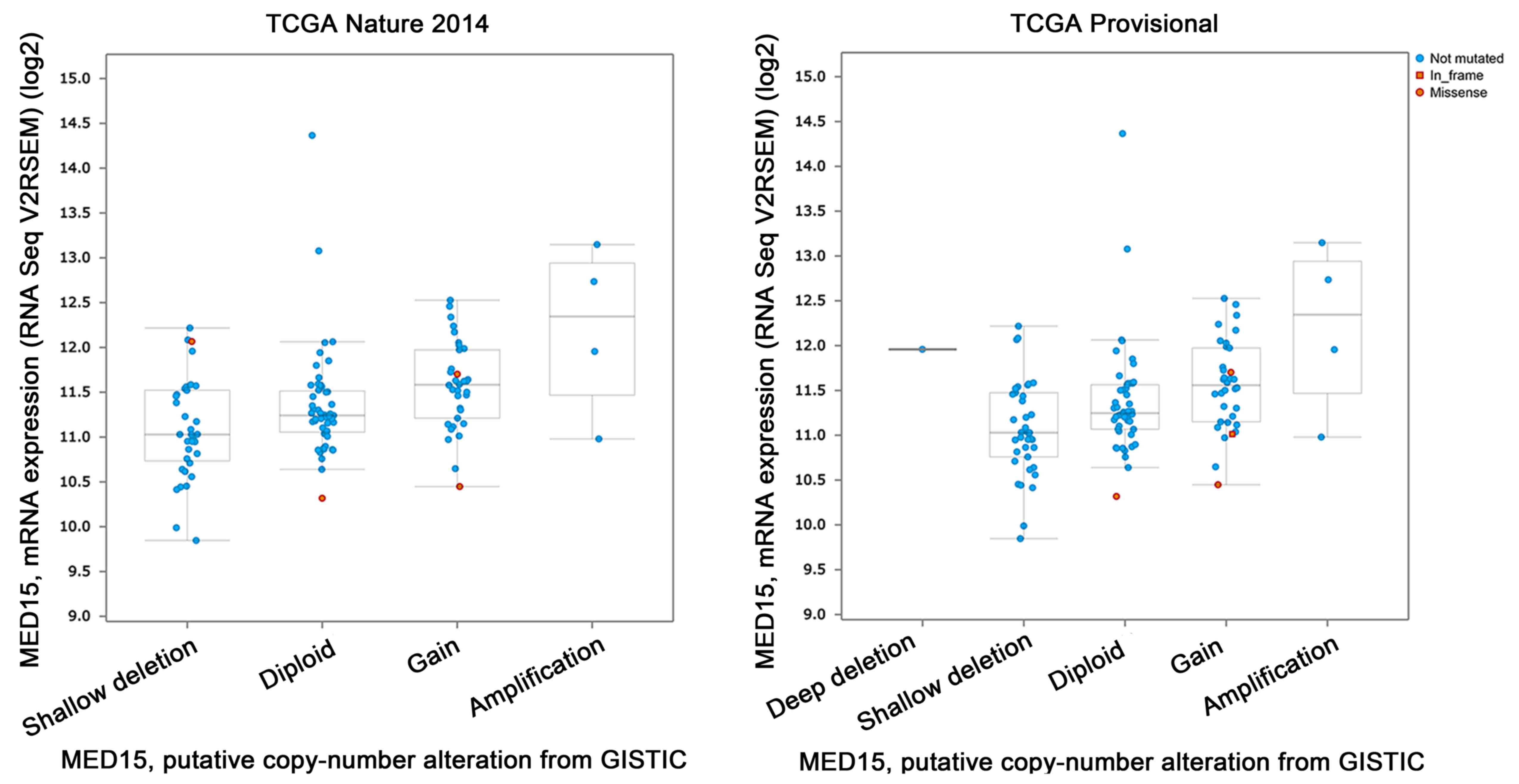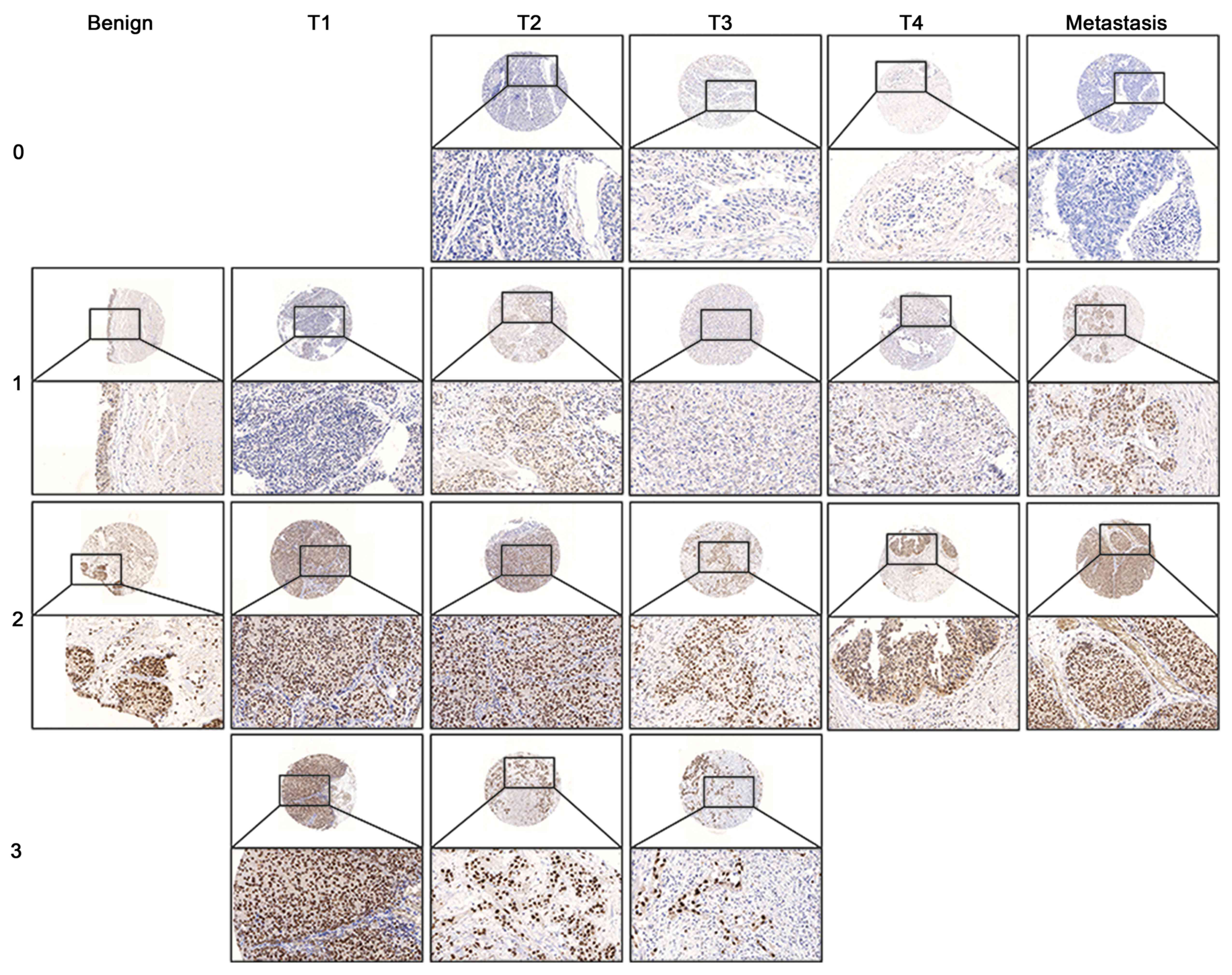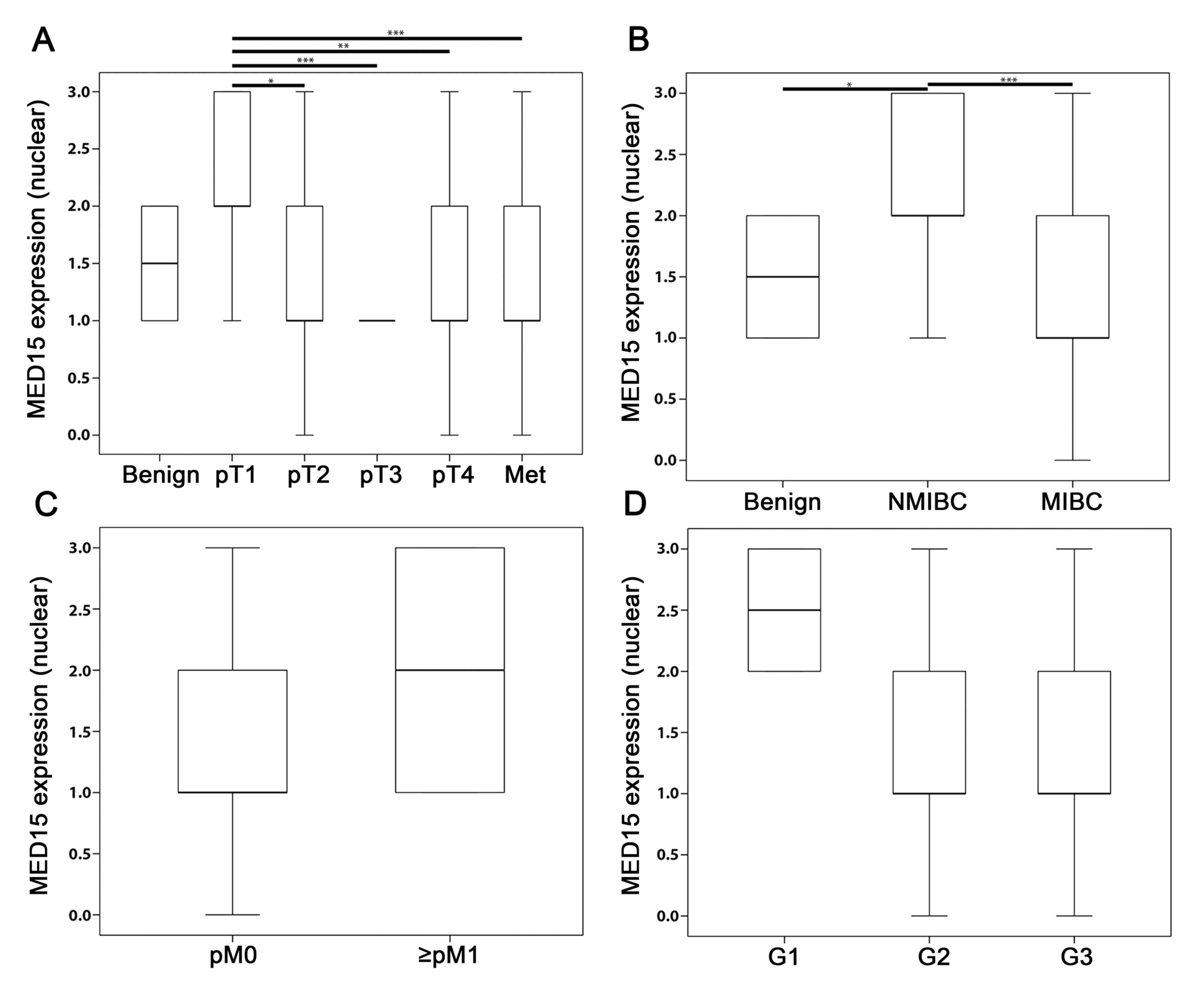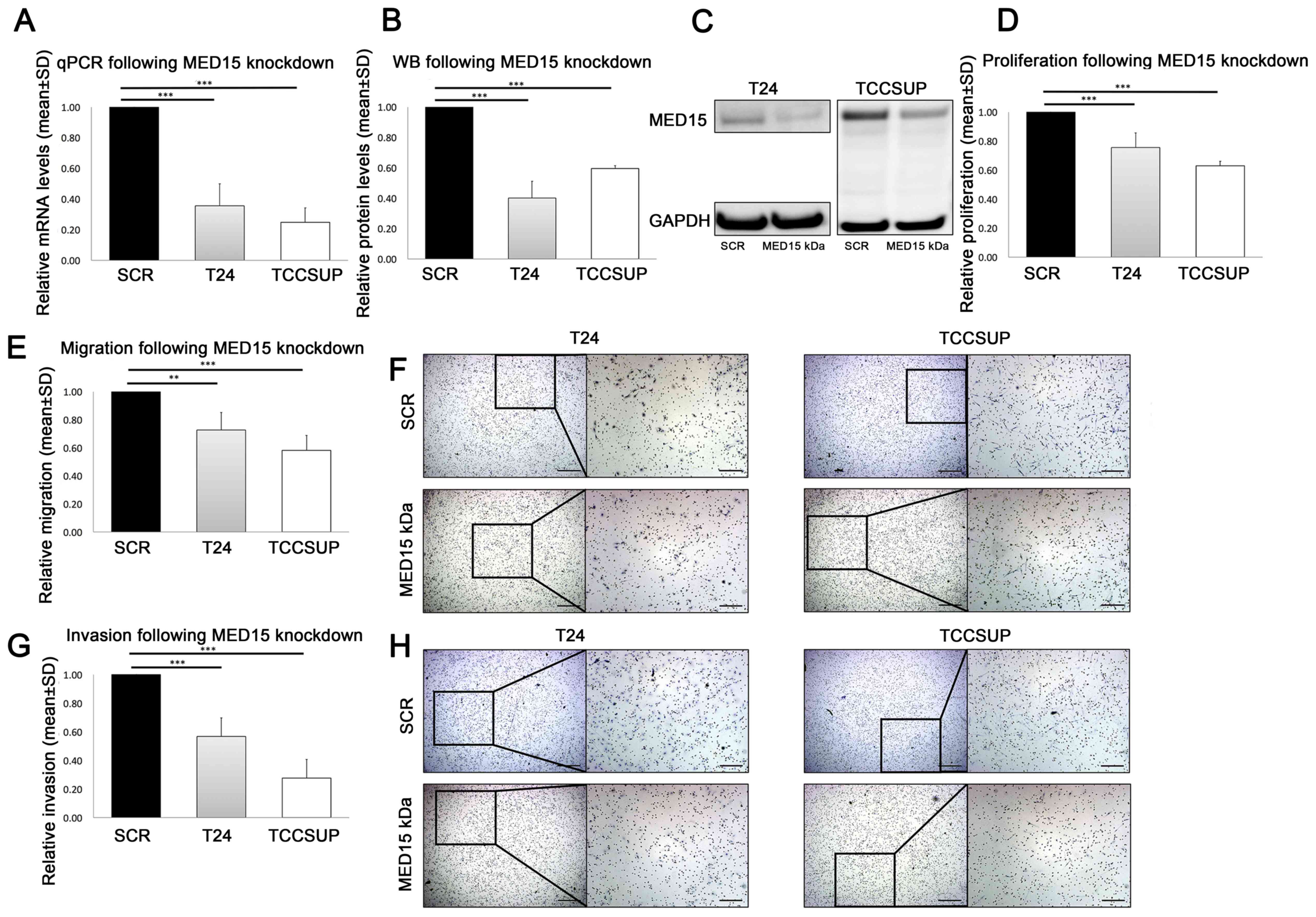The knockdown of the Mediator complex subunit MED15 restrains urothelial bladder cancer cells' malignancy
- Authors:
- Published online on: June 25, 2018 https://doi.org/10.3892/ol.2018.9014
- Pages: 3013-3021
-
Copyright: © Syring et al. This is an open access article distributed under the terms of Creative Commons Attribution License.
Abstract
Introduction
Urothelial bladder cancer (BCa) is the ninth most common cancer worldwide, with an estimated 430,000 new cases in 2012. More than 60% of all BCa cases and half of the total 165,000 BCa deaths occur in the less developed regions of the world. A strong predominance of male patients is observed, with three-quarters of all BCa cases occurring in men (1). Overall, it has a significant impact on public health (2).
Approximately 75% of the newly diagnosed BCas are non-muscle invasive bladder cancer (NMIBC) and have a high rate of recurrence (60–70%) and progression to muscle-invasive disease bladder cancer (MIBC, 10–20%), despite local therapy. The remaining 25% of the newly diagnosed BCas present with muscle invasion and need either radical surgery or radiotherapy. However, these cases often have poor outcomes despite systemic therapy (3,4). MIBC has the worst prognosis, with a 5-year survival rate of less than 50% of the cases (5).
BCa has a high degree of mutational heterogeneity and a high frequency of somatic mutations compared with other solid tumors. Mutational heterogeneity is mediated by multiple factors, which include enzyme catalytic polypeptide family of enzymes and smoking exposure among others. The mutational landscape of urothelial carcinoma, including specific mutations in pathways and driver genes, such as FGFR3, ERBB2, PIK3CA, TP53 (p53), and RB1, affects tumor aggressiveness and response to therapy (6,7).
Mediator subunit 15 (MED15) is a subunit of the multiprotein Mediator complex, which can be divided into four modules: The head, middle, tail, and kinase, and is comprised of ≈33 subunits in humans. The Mediator complex functions as a bridge between regulatory proteins and RNA polymerase II (Pol II), thereby regulating the Pol II-dependent transcription (8–11). Several studies reported altered expressions of distinct subunits in human malignancy. Even in breast cancer, MED15 seems to be a crucial cofactor for TGFβ signalling, and the MED15 deficiency attenuates the TGFβ-targeted gene expression and hinders the TGFβ-induced epithelial-mesenchymal transition (EMT) (12). Additionally, in head and neck squamous cell carcinoma (HNSCC), MED15 has been found to be overexpressed, especially in recurrent tumors possessing an aggressive phenotype (13).
Till now, we have only a rudimentary knowledge of the role of the Mediator complex in BCa. In comparison to benign tissue, an overexpression of MED19 has been detected in BCa. Additionally, the knockdown of MED19 leads to a reduced growth of the carcinoma cell lines (14). Contrary to this, the expression of MED1 significantly decreases during BCa progression from benign urothelium to advanced BCa, and cancer-specific survival (CSS) was significantly worse in the group that had low MED1 expression (15).
Till now, nothing is known about MED15 in urothelial BCa; so, this has led us to investigate its expression and functional properties.
Materials and methods
Ethics statement
This investigation was conducted in accordance with ethical standards, the Declaration of Helsinki, and national and international guidelines. Ethical approval for using human material in the present study was obtained from the Internal Review Board of the University Hospital of Bonn (IRB nos. 036/08 and 093/12). The participants of the study agreed in writing beforehand and were anonymised before inclusion in the study cohort.
RNA expression analysis by cBioPortal
The database cBioPortal for cancer genomics (http://cbioportal.org; version 1.4.0) was utilized in January 2017 to investigate the mRNA expression of MED15 in BCa extended by the use of survival analysis.
cBioPortal provides a Web resource for exploring, visualising, and analysing multidimensional cancer genomics data. The portal reduces molecular profiling data from cancer tissues and cell lines into readily understandable genetic, epigenetic, gene expression and proteomic events (16,17). For the analysis, RNA sequencing data from The Cancer Genome Atlas (TCGA) (18) were used (RNA Seq V2 RSEM) with two SDs from the mean and a threshold of ±2.0. The mRNA z-scores were precomputed from the expression values and were compared to the expression distribution of each gene associated with the tumors that are diploid for this gene (16). Two mRNA analyses for BCa, named ‘Bladder Urothelial Carcinoma (TCGA, Provisional)’ and ‘Bladder Urothelial Carcinoma (TCGA, Nature 2014)’ are available on cBioPortal with 408 and 129 samples, respectively.
Additionally, a mutation analysis was performed in both data sets using cBioPortal [Copy number alterations, mRNA expression (RNA Seq V RSEM)].
Immunohistochemistry (IHC)
Tissue microarray (TMA) construction
A total of 182 specimens were used for this study. The urothelial BCa cohort, provided by the Clinic for Urology of the University Hospital Bonn, contained a total of 18 benign samples, 126 BCa samples, and 38 metastases derived from BCa (Table I).
TMAs were performed as described previously (19,20). Briefly, formalin-fixed paraffin-embedded (FFPE) tissues were cut into 4-µm-thick sections and mounted on slides. After staining with haematoxylin and eosin (H&E), relevant areas of benign tissue and primary tumor were identified and circled by a pathologist. Each tumor and the corresponding benign region were represented with up to three cores measuring 0.6 mm in diameter on a TMA recipient block using a semiautomatic tissue arrayer (Beecher Instruments, Sun Prairie, WI, USA). H&E TMA sections were assessed again to confirm the histology.
MED15 protein expression analysis by IHC
Prior to performing IHC analyses in the selected TMAs, the specificity of the antibody was confirmed according to the manufacturer's instructions by using non-seminomatous germ cell tumor (NSGCT) as a positive control. IHC was performed using the Ventana Benchmark automated staining system (Ventana Medical System, Tuscon, AZ, USA). In short, slides were incubated with the primary antibody according to the manufacturer's instructions: Anti-MED15 rabbit polyclonal (1:50, clone 11566-1-AP; ProteinTech Group, Inc., Chicago, IL, USA) at room temperature; antibody dilution was conducted using a Ventana diluent. For signal detection, the ultraView Universal DAB detection kit (Ventana Medical System) was used. Finally, slides were counterstained with haematoxylin and bluing reagent, dehydrated, and mounted.
After IHC was performed, the staining was evaluated independently by two pathologists (GK and TM). Only cases with at least one assessable TMA core that had sufficient tumor tissue were included in the analysis. Quantification of nuclear protein expression was evaluated according to a score of 0 (=no expression) to 3 (=high expression). The cut-off used to determine a nuclear MED15 overexpression (≥2) was consistently set above the expression of benign samples.
Functional investigations
Cell lines and culture conditions
Urothelial BCa cell lines T24 and TCCSUP were purchased from the American Type Culture Collection (ATCC, Manassas, VA, USA) and were grown in a 5% CO2 incubator at 37°C and 85% humidity. Monolayer cultures were maintained in the RPMI-1640 medium (Biochrom AG, Berlin, Germany) that was supplemented with 10% heat-inactivated foetal calf serum (FCS; Sigma-Aldrich; Merck KGaA, Darmstadt, Germany), 1% streptomycin-penicillin antibiotics (Gibco; Thermo Fisher Scientific, Inc., Waltham, MA, USA), and 1% glutamine (Thermo Fisher Scientific, Inc., Darmstadt, Germany).
Small interfering (si)RNA mediated MED15 knockdown
The cell transfections in the cell lines T24 and TCCSUP were carried out with 100 nmol/l siRNA using Screenfect A (Genaxxon Bioscience GmbH, Ulm, Germany) for 48 (for PCR) and 72 h (for western blotting), respectively. MED15 siRNA (sc-75767; Santa Cruz Biotechnology, Inc., Dallas, TX, USA) is a pool of three target-specific siRNAs designed to knockdown gene expression. A non-targeting scrambled siRNA was used as negative control (Exiqon Life Sciences, Copenhagen, Denmark).
Western blotting
Post-transfected cells were washed with ice-cold phosphate-buffered saline (PBS) and lysed in a protein extraction buffer for 30 min. In addition, samples were sonicated for 2 min and subsequently centrifuged at 16,000 × g for 30 min at 4°C. Protein concentration was measured using bicinchoninic acid (BCA) Protein Assay kit (Thermo Fisher Scientific, Inc., Waltham, MA, USA), fractionated by SDS-PAGE and transferred to a nitrocellulose membrane. After incubation with 5% non-fat milk in TBST (50 mM Tris, 150 mM NaCl, 0.05% Tween-20, pH 7.5) for 60 min, the membrane was incubated with anti-MED15 rabbit polyclonal (1:500, clone 11566-1-AP; ProteinTech Group, Inc.) or anti-GAPDH rabbit monoclonal (1:2,000, clone 14C10; Cell Signaling Technology, Inc., Danvers, MA, USA) primary antibodies at 4°C overnight. Then, the membrane is washed three times for 5 min with TBST and incubated with horseradish peroxidase conjugated anti-rabbit antibody for 1 h at room temperature. Staining was detected using SuperSignal West Femto Maximum Sensitivity Substrate, an ultra-sensitive enhanced chemiluminescence (ECL) substrate (Thermo Fisher Scientific, Inc.).
Reverse transcription-quantitative PCR (RT-qPCR)
RNA was isolated from cell line pellets using the Total RNA Purification Mini Spin Column Kit (Genaxxon Bioscience GmbH, Ulm, Germany). RNA quantity and quality were analysed using a NanoDrop 2000 spectrophotometer (Thermo Fisher Scientific, Inc., Wilmington, DE, USA). cDNA was synthesised using 200 ng total RNA and the PrimeScript RT Reagent kit with gDNA Eraser (Takara Bio, Saint-Germain-en-Laye, France). qPCR was performed using 5 ng/µl cDNA, Takara Bio SYBR Premix Ex Taq II with ROX Plus, and 10 pmol/µl forward and reverse primer. The following primer sequences were used: MED15, forward: 5′-TTGAGGATGATGAGCGGCAG-3′, reverse: 5′-GGAGGTCCTTGTCATCCAGC-3′; and β-actin, Forward: 5′-CCAACCGCGAGAAGATGA-3′, reverse: 5′-CCAGAGGCGTACAGGGATAG-3′. PCR was performed on an ABIPrism 7900 HT Fast Real-Time PCR System (Applied Biosystems; Thermo Fisher Scientific, Inc.). Data were analysed using Qbase+ (Biogazelle, Ghent, Belgium) with β-actin as reference gene, applying the 2−∆∆Cq algorithm.
EZ4U cell proliferation assay
The EZ4U cell proliferation assay kit was used according to the manufacturer's protocol (EZ4U; Biomedica Group, Vienna, Austria). The siRNA transfections for proliferation assays were performed in 96-well plates. In each well of a flat-bottom 96-well plate, either 1.2×104 cells (T24) or 2.0×104 cells (TCCSUP) were seeded in 200 µl cell culture medium. siRNA-mediated MED15 knockdown was then performed, and cells were incubated to adhere and grow for 72 h. After incubation, 20 µl of EZ4U substrate solutions were added before incubating the resultant solution for 3 h (T24) and 4 h (TCCSUP) until the color of the solution changed from yellow to orange. The absorbance was measured using a microplate reader (Tecan Spectra Rainbow microplate reader; Tecan Deutschland GmbH, Crailsheim, Germany) at 450 nm wavelength. Each experiment was repeated at least three times.
Migration assays
The siRNA transfections for migration assays were performed in 6-well plates. 48 h post transfection, cells were trypsinised and seeded into migration Boyden chambers. 3×104 (T24) or 5×104 cells (TCCSUP) were plated in the upper chamber of migration inserts (VWR, Darmstadt, Germany) containing 0% FCS medium. The lower chamber was filled with medium containing 10% FCS for chemotactic attraction. After 24 h of incubation, cells on the upper surface were removed with the help of a cotton swab. BCa cells invading the lower surface of membrane were fixed with 4% paraformaldehyde (Merck KGaA, Darmstadt, Germany), stained with haematoxylin (Waldeck, Münster, Germany), and washed with water. Membranes were scanned and manually evaluated in four randomly selected fields by counting. Each experiment was repeated at least three times.
Invasion assays
The invasion analysis was carried out in a similar as the migration except for the use of Matrigel invasion chambers (VWR) and a cell number of 7.5×104 per well.
Clinical data and statistics
For IHC, associations with clinical-pathological parameters were performed. Survival analysis was evaluated with the help of the Kaplan-Meier estimator and log rank tests. Statistical evaluation was performed in Microsoft Excel and SPSS. The IHC data were not normal distributed, so we performed a non-parametric test. When comparing more than two sets of numerical data, a multiple group comparison test such as Kruskal-Wallis test was followed by a post hoc test such as Dunn-Bonferroni test. When comparing two or less sets of numerical data, the Mann-Whitney U test was applied. The data were analysed anonymously.
For the statistical analysis of the functional investigations in the cell lines, we compared the results of scrambled RNA and target RNA on the one hand in TCCSUP and on the other hand in the T24. The respective cell line had its own scrambled control. The respective ‘scrambled’ control was set to 1. Due to the fact that the data were distributed normally, the parametric test was performed and because of two and less groups the unpaired t-test was used.
The cell lines with each other have not been compared statistically.
Results
Transcriptional expression of the MED15 by cBioPortal
Using the cBioPortal database, we analysed the mRNA expression of MED15 in BCa samples. In the two analyses, 408 and 129 samples of BCa were investigated. The results of the expression analyses are shown in Fig. 1.
Transcriptional expression regarding the database cBioPortal
In both analyses, named ‘Bladder Urothelial Carcinoma (TCGA, Provisional)’ and ‘Bladder Urothelial Carcinoma (TCGA, Nature 2014)’, an alteration of MED15 is described in 2.9% (12/408) and 2.3% (3/129), respectively. All of the alterations are upregulations of MED15 mRNA expression (Fig. 1).
Survival analysis regarding transcriptional expression
Due to the small number of alterations and events in both the analyses, there are no significant differences in overall- and progression-free-survival. Additionally, the analyses cannot really determine a tendency (data not shown).
Mutation analysis of MED15 in BCa
As shown in Fig. 2, in the TCGA 2014 analysis (n=130), the following mutation profiles were found: Shallow deletions (n=38), diploid (n=51), gain-of-function (n=34) and amplification (n=4). However, the amplification logically led to the highest mRNA expression. Missense mutations are found four times; no in-frame mutation.
The TCGA Provisional analysis (n=130) shows a similar profile: Deep deletion (n=1), shallow deletion (n=39), diploid (n=49), gain of function (n=34), amplification (n=4). Again, the amplification leads to the highest mRNA expression. This analysis revealed three missense and one in-frame mutations.
IHC and functional investigations
In order to further illuminate the expression and role of MED15 in BCa, we performed IHC staining on a TMA cohort with the available clinical information and functional analysis in cell lines of essential tumor parameters.
IHC staining shows MED15 nuclear expression in benign, tumor and metastasis tissue (Fig. 3). A MED15 cytoplasmic expression seemed not to be specific, since almost every sample shows a weak cytoplasmic signal. There are no differences here. The expression of MED15 in BCa was just found in epithelial cells. In the stroma, only a few fibroblasts displayed a weak non-specific expression, comparable to the cytoplasm. For IHC, we found MED15 to have a higher expression in NMIBC (staining score=2.0) compared to benign (staining score=1.5, P=0.028) and MIBC (staining score=1.0, P≤0.001; Fig. 4A and B). The overexpression of MED15 in BCa did not associate with positive lymphnode- or distant-metastasis stage [N: P=0.252 (data not shown), M: P=0.434; Fig. 4C] or the grading status of the tumor (Fig. 4D). Unfortunately, no significant differences between samples with or without overexpression (staining score >2) of MED15 have been found for CSS (P=0.770) and progression-free survival (PFS, P=0.503) (data not shown) for survival analysis of the IHC. An evaluation of the pure MED15 expression (division into positive and negative, without definition of an intensity or overexpression) on the basis of the clinicopathological data can be found in Table II.
Table II.Overview of MED15 expression in the BCa cohort divided into positive and negative expression based on the clinicopathological parameters. |
To investigate the functional role of the subunit MED15 in malignant progression and metastasis, we performed in vitro siRNA-mediated knockdown of MED15 in the BCa cell lines T24 (P≤0.001) and TCCSUP (P≤0.001; Fig. 5A-C). Thereafter, we compared the measured proliferative activity of scrambled control and MED15 knockdown cells and observed a significant decrease in T24 (P=≤0.001) and TCCSUP (P≤0.001; Fig. 5D). Further, migration and invasion were significantly reduced in T24 (migration P=0.003, invasion P≤0.001) and TCCSUP (migration P≤0.001, invasion P≤0.001) cells following the transient MED15 knockdown, compared to scrambled control cells (Fig. 5E-H). In conclusion, MED15 knockdown led to reduced malignant behaviour in the BCa cell lines T24 and TCCSUP.
Discussion
Considering its high incidence, urothelial BCa is a high-priority concern in urology. In the non-muscle invasive stage, the BCa requires intensive treatment due to the frequent recurrences. Additionally, the muscle invasive stage demands extensive therapy and care (2–4). Due to this, comprehensive studies of BCa have to be continued and expanded.
Over the last ten years, the Mediator complex has been well investigated and illuminated in humans, yeast, and plants (21,22). The Mediator complex is a multi-protein complex that links enhancer bound transcription factors (TF) to specific promoter regions and, thereby, activates transcription. In mammals, this complex consists of ≈33 subunits, and its composition can change to alter its biological function. Furthermore, the specificity of the Mediator complex is mediated by various domains that interact with different TFs (23). The precise mechanisms through which the Mediator complex regulates Pol II activity remain poorly understood; However it has been observed that they involve extensive protein-protein interactions between the Mediator complex, pol II, and other general and gene-specific transcription regulatory factors (21).
The roles of individual subunits have been described in various diseases, such as intellectual disability (24), cardiovascular disease (25), and carcinogenesis (26). However, much remains unknown.
Little information is available pertaining to the BCa especially. Till now, only the overexpression of MED19 has been observed to be associated with higher tumor stages (14), while a MED1 underexpression accompanies a worse survival rate (15).
In our investigation, we found out that the knockdown of MED15 in BCa cell lines leads to a downregulation of the tumor parameters of proliferation, migration, and invasion in the functional analysis. These parameters are decisive for the recurrence and progression of urothelial BCa. Unfortunately, the survival data of mRNA and IHC analyses did not show any significant differences in the overexpression of MED15. Some results from the IHC analysis also contrast the results obtained from the cell line examinations (higher expression of MED15 in NMIBC or in low grading status). The cause of these deviant results may be the rather small number of samples in the IHC analysis. In addition, the cohort shows significant differences in the individual group sizes (NMIBC n=24, MIBC n=102, benign n=18). Expecting, a larger and balanced number of samples would lead to possibly more clear results.
Controversial expression profiles can also be found for the same subunit in other studies, MED1 for example. In osteosarcoma, the knockdown of MED1 reduced the proliferation (27), whereas in non-small lung cancer the loss of MED1 led to an increase of invasion and metastases (28).
Possible explanations for aberrant expression profiles can be found in the connection to different pathways. For MED1, the interaction with receptor tyrosine kinases (RTKs) resulted in Tamoxifen resistance (29). The involvement of the Apaf-1-dependent pathway/Apaf1-dependent apoptotic pathway was found in the downregulation of MED19 in human laryngocarcinoma HEp2 cells (30). For MED15, a connection to the TGFβ- (13) and PI3K/mTOR- (31) signalling pathways was already described in head and neck cancer and prostate cancer. Whether this is also true for BCa is to be determined in subsequent investigations. Certainly, for BCa, the involvement of these and more signalling pathways have been described: The PI3K/Akt-, as a cellular signalling pathway, rapidly activates downstream pathways of inflammation and neoplasia in bladder urothelium (32). Additionally, the p53/pRb signal pathway regulates the BCa cell cycle (33). Furthermore, the tyrosine kinase pathway with the epidermal growth factor receptor-(EGFR) family was reported to be overexpressed in BCa, and tyrosine kinase inhibitors (TKIs) have been suggested as treatment by the strong inhibition of the cell proliferation and induction of cell cycle G1 arrest and apoptosis in UM-UC-5 cells (34).
Thus, further analyses are necessary, especially that will include larger sample sizes. Additionally, whether the mentioned and already described signalling pathways for MED15 or BCa are also included in the regulation of MED15 in BCa, needs to be investigated in further studies. However, we concluded that MED15 is involved in the important tumor parameters proliferation, migration and invasion.
We concluded that the knockdown of the Mediator complex subunit MED15 restrains urothelial BCa cells' malignancy. Our work is to be considered as the first overview-study on the role of MED15 in BCa, and further investigations pertaining to the underlying signal pathways are necessary.
Acknowledgements
Not applicable.
Funding
The study was supported by the Ferdinand Eisenberger Fellowship of the German Society of Urology (DGU; SYI1/FE-13) and the Maria von Linden-Program of the University of Bonn for IS.
Availability of data and materials
The datasets used and/or analyzed during the current study are available from the corresponding author on reasonable request.
Authors' contributions
IS, RW and JE designed the study. IS, RW, DS, SS performed the experiments. IS, RW, TM, GK, SCM and JE analyzed and interpreted the results. IS wrote the manuscript with input from all authors. All authors read and approved the final manuscript.
Ethics approval and consent to participate
This investigation was conducted in accordance with ethical standards, the Declaraion of Helsinki, and national and international guidelines. Ethical approval for using human material in the present study was obtained from the Internal Review Board of the University Hospital of Bonn (IRB nos. 036/08 and 093/12). The participants of the study agreed in writing beforehand and were anonymised before inclusion in the study cohort.
Consent for publication
Not applicable.
Competing interests
The authors declare that they have no competing interests.
References
|
Antoni S, Ferlay J, Soerjomataram I, Znaor A, Jemal A and Bray F: Bladder cancer incidence and mortality: A global overview and recent trends. Eur Urol. 71:96–108. 2017. View Article : Google Scholar : PubMed/NCBI | |
|
Sievert KD, Amend B, Nagele U, Schilling D, Bedke J, Horstmann M, Hennenlotter J, Kruck S and Stenzl A: Economic aspects of bladder cancer: What are the benefits and costs? World J Urol. 27:295–300. 2009. View Article : Google Scholar : PubMed/NCBI | |
|
Babjuk M, Oosterlinck W, Sylvester R, Kaasinen E, Böhle A, Palou-Redorta J and Rouprêt M: European association of urology (EAU): EAU guidelines on non-muscle-invasive urothelial carcinoma of the bladder, the 2011 update. Eur Urol. 59:997–1008. 2011. View Article : Google Scholar : PubMed/NCBI | |
|
Stenzl A, Cowan NC, De Santis M, Kuczyk MA, Merseburger AS, Ribal MJ, Sherif A and Witjes JA: European association of urology (EAU): Treatment of muscle-invasive and metastatic bladder cancer: Update of the EAU guidelines. Eur Urol. 59:1009–1018. 2011. View Article : Google Scholar : PubMed/NCBI | |
|
Wei L, Chintala S, Ciamporcero E, Ramakrishnan S, Elbanna M, Wang J, Hu Q, Glenn ST, Murakami M, Liu L, et al: Genomic profiling is predictive of response to cisplatin treatment but not to PI3K inhibition in bladder cancer patient-derived xenografts. Oncotarget. 7:76374–76389. 2016. View Article : Google Scholar : PubMed/NCBI | |
|
Glaser AP, Fantini D, Shilatifard A, Schaeffer EM and Meeks JJ: The evolving genomic landscape of urothelial carcinoma. Nat Rev Urol. 14:215–229. 2017. View Article : Google Scholar : PubMed/NCBI | |
|
Choi W, Ochoa A, McConkey DJ, Aine M, Höglund M, Kim WY, Real FX, Kiltie AE, Milsom I, Dyrskjøt L and Lerner SP: Genetic alterations in the molecular subtypes of bladder cancer: Illustration in the cancer genome atlas dataset. Eur Urol. 72:354–365. 2017. View Article : Google Scholar : PubMed/NCBI | |
|
Malik S and Roeder RG: The metazoan mediator co-activator complex as an integrative hub for transcriptional regulation. Nat Rev Genet. 11:761–772. 2010. View Article : Google Scholar : PubMed/NCBI | |
|
Cai G, Imasaki T, Takagi Y and Asturias FJ: Mediator structural conservation and implications for the regulation mechanism. Structure. 17:559–567. 2009. View Article : Google Scholar : PubMed/NCBI | |
|
Ansari SA and Morse RH: Mechanisms of mediator complex action in transcriptional activation. Cell Mol Life Sci. 70:2743–2756. 2013. View Article : Google Scholar : PubMed/NCBI | |
|
Boube M, Joulia L, Cribbs DL and Bourbon HM: Evidence for a mediator of RNA polymerase II transcriptional regulation conserved from yeast to man. Cell. 110:143–151. 2002. View Article : Google Scholar : PubMed/NCBI | |
|
Zhao M, Yang X, Fu Y, Wang H, Ning Y, Yan J, Chen YG and Wang G: Mediator MED15 modulates transforming growth factor beta (TGFβ)/Smad signaling and breast cancer cell metastasis. J Mol Cell Biol. 5:57–60. 2013. View Article : Google Scholar : PubMed/NCBI | |
|
Offermann A, Shaikhibrahim Z and Perner S: MED15: A potential biomarker for head and neck squamous cell carcinoma? Biomark Med. 9:939–941. 2015. View Article : Google Scholar : PubMed/NCBI | |
|
Zhang H, Jiang H, Wang W, Gong J, Zhang L, Chen Z and Ding Q: Expression of Med19 in bladder cancer tissues and its role on bladder cancer cell growth. Urol Oncol. 30:920–927. 2012. View Article : Google Scholar : PubMed/NCBI | |
|
Klümper N, Syring I, Vogel W, Schmidt D, Müller SC, Ellinger J, Shaikhibrahim Z, Brägelmann J and Perner S: Mediator complex subunit MED1 protein expression Is decreased during bladder cancer progression. Front Med (Lausanne). 4:302017.PubMed/NCBI | |
|
Gao J, Aksoy BA, Dogrusoz U, Dresdner G, Gross B, Sumer SO, Sun Y, Jacobsen A, Sinha R, Larsson E, et al: Integrative analysis of complex cancer genomics and clinical profiles using the cBioPortal. Sci Signal. 6:pl12013. View Article : Google Scholar : PubMed/NCBI | |
|
Cerami E, Gao J, Dogrusoz U, Gross BE, Sumer SO, Aksoy BA, Jacobsen A, Byrne CJ, Heuer ML, Larsson E, et al: The cBio cancer genomics portal: An open platform for exploring multidimensional cancer genomics data. Cancer Discov. 2:401–404. 2012. View Article : Google Scholar : PubMed/NCBI | |
|
Tomczak K, Czerwińska P and Wiznerowicz M: The cancer genome atlas (TCGA): An immeasurable source of knowledge. Contemp Oncol (Pozn). 19:A68–A77. 2015.PubMed/NCBI | |
|
Scheble VJ, Braun M, Wilbertz T, Stiedl AC, Petersen K, Schilling D, Reischl M, Seitz G, Fend F, Kristiansen G and Perner S: ERG rearrangement in small cell prostatic and lung cancer. Histopathology. 56:937–943. 2010. View Article : Google Scholar : PubMed/NCBI | |
|
Scheble VJ, Braun M, Beroukhim R, Mermel CH, Ruiz C, Wilbertz T, Stiedl AC, Petersen K, Reischl M, Kuefer R, et al: ERG rearrangement is specific to prostate cancer and does not occur in any other common tumor. Mod Pathol. 23:1061–1067. 2010. View Article : Google Scholar : PubMed/NCBI | |
|
Allen BL and Taatjes DJ: The mediator complex: A central integrator of transcription. Nat Rev Mol Cell Biol. 16:155–166. 2015. View Article : Google Scholar : PubMed/NCBI | |
|
Dolan WL and Chapple C: Conservation and divergence of Mediator structure and function: Insights from plants. Plant Cell Physiol. 58:4–21. 2017.PubMed/NCBI | |
|
Kosan C and Godmann M: Bringing light into gene regulation in hematopoietic stem cells by the Mediator complex. Stem Cell Investig. 4:102017. View Article : Google Scholar : PubMed/NCBI | |
|
Caro-Llopis A, Rosello M, Orellana C, Oltra S, Monfort S, Mayo S and Martinez F: De novo mutations in genes of Mediator complex causing syndromic intellectual disability: Mediatorpathy or transcriptomopathy? Pediatr Res. 80:809–815. 2016. View Article : Google Scholar : PubMed/NCBI | |
|
Schiano C, Casamassimi A, Vietri MT, Rienzo M and Napoli C: The roles of Mediator complex in cardiovascular diseases. Biochim Biophys Acta. 1839:444–451. 2014. View Article : Google Scholar : PubMed/NCBI | |
|
Schiano C, Casamassimi A, Rienzo M, de Nigris F, Sommese L and Napoli C: Involvement of Mediator complex in malignancy. Biochim Biophys Acta. 1845:66–83. 2014.PubMed/NCBI | |
|
Jiang C, Chen H, Shao L and Wang Q: MicroRNA-1 functions as a potential tumor suppressor in osteosarcoma by targeting Med1 and Med31. Oncol Rep. 32:1249–1256. 2014. View Article : Google Scholar : PubMed/NCBI | |
|
Kim HJ, Roh MS, Son CH, Kim AJ, Jee HJ, Song N, Kim M, Seo SY, Yoo YH and Yun J: Loss of Med1/TRAP220 promotes the invasion and metastasis of human non-small-cell lung cancer cells by modulating the expression of metastasis-related genes. Cancer Lett. 321:195–202. 2012. View Article : Google Scholar : PubMed/NCBI | |
|
Mansouri S, Naghavi-Al-Hosseini F, Farahmand L and Majidzadeh-A K: MED1 may explain the interaction between receptor tyrosine kinases and ERα66 in the complicated network of Tamoxifen resistance. Eur J Pharmacol. 804:78–81. 2017. View Article : Google Scholar : PubMed/NCBI | |
|
Zhao Y, Meng Q, Gao X, Zhang L and An L: Down-regulation of Mediator complex subunit 19 (Med19) induces apoptosis in human laryngocarcinoma HEp2 cells in an Apaf-1-dependent pathway. Am J Transl Res. 9:755–761. 2017.PubMed/NCBI | |
|
Offermann A, Vlasic I, Syring I, Vogel W, Ruiz C, Zellweger T, Rentsch CA, Hagedorn S, Behrends J, Nowak M, et al: MED15 overexpression in prostate cancer arises during androgen deprivation therapy via PI3K/mTOR signaling. Oncotarget. 8:7964–7976. 2017. View Article : Google Scholar : PubMed/NCBI | |
|
Tamarkin FJ, Kang WS, Cohen JJ, Wheeler MA and Weiss RM: A role for Akt in the rapid regulation of inflammatory and apoptotic pathways in mouse bladder. Naunyn Schmiedebergs Arch Pharmacol. 373:349–359. 2006. View Article : Google Scholar : PubMed/NCBI | |
|
Kiselyov A, Bunimovich-Mendrazitsky S and Startsev V: Key signaling pathways in the muscle-invasive bladder carcinoma: Clinical markers for disease modeling and optimized treatment. Int J Cancer. 138:2562–2569. 2016. View Article : Google Scholar : PubMed/NCBI | |
|
Li J, Lv B, Li X, He Z and Zhou K: Apoptosis-related molecular differences for response to tyrosin kinase inhibitors in drug-sensitive and drug-resistant human bladder cancer cells. J Cancer Res Ther. 9:668–671. 2013. View Article : Google Scholar : PubMed/NCBI |



